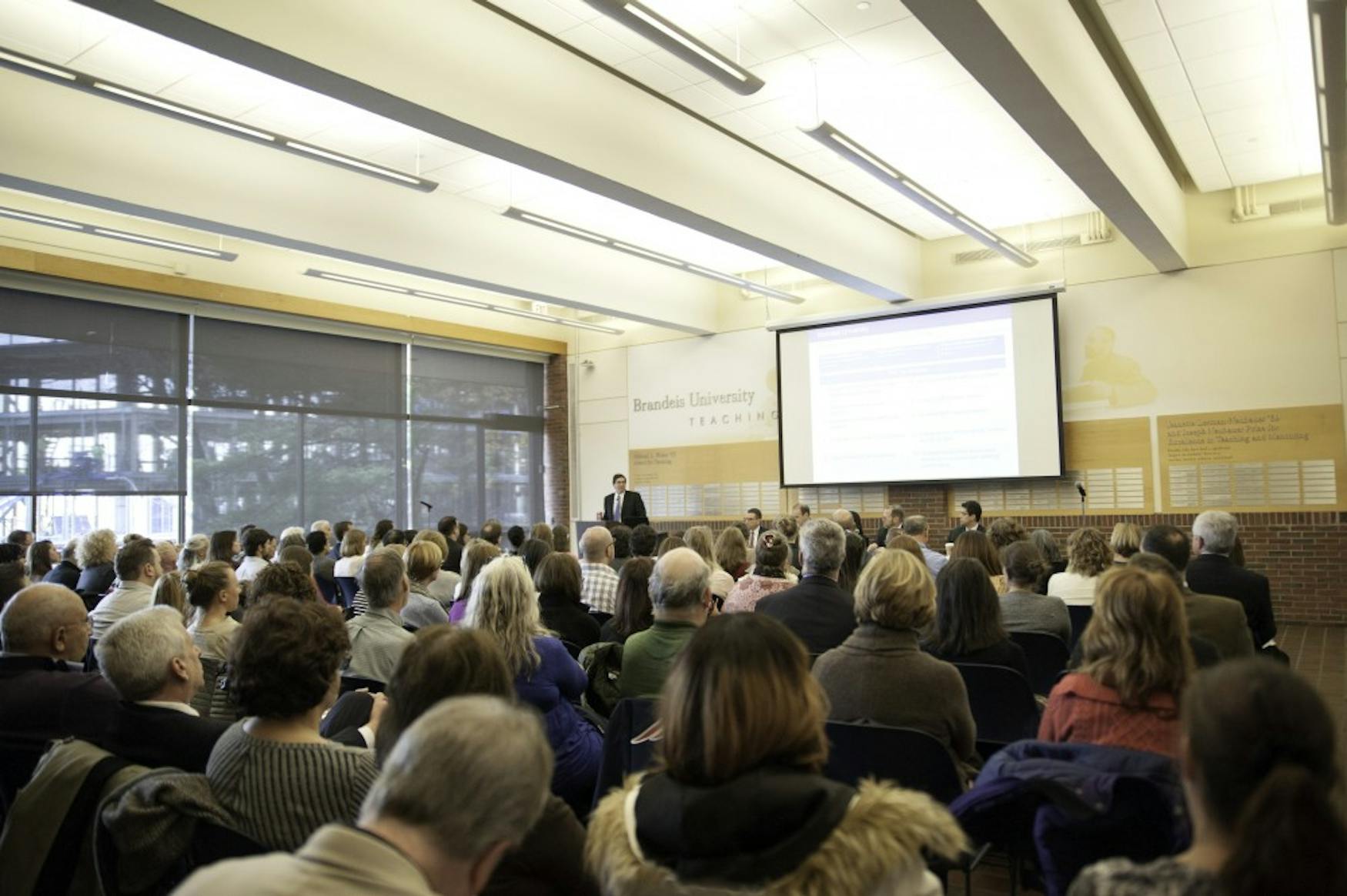Finance administrators meet with community in forum
Brandeis’ endowment falls short in comparison to peer institutions, creating an unsustainable and constrained budget, according to various administrators who spoke at an open forum Tuesday evening.
Convened by University President Ron Liebowitz and Steve Uretsky, the executive vice president for finance and administration, the forum also outlined financial and administrative goals for the coming fiscal year. These included developing a University financial framework and long-range financial models, supporting campus dialogue on divestment and reviewing benefits and wellness programs.
It has been at least a decade since the University has done an indirect cost analysis to evaluate Brandeis’ yearly and long term budget, according to Uretsky. In an effort to promote transparency around the University’s financial, administrative and operational functions, Uretsky, as well as Sam Solomon, the University’s chief financial officer, revealed that the University is “financially viable but constrained.”
The current market value of the University’s endowment is $976 million, meaning the University would have to raise $900 million, nearly double the current amount, in order to match the median endowment per student of peer schools like Princeton University, Johns Hopkins University and Northwestern University.
Solomon also explained that although the last fiscal year marks the third straight year of a surplus, the profit margin that the University is generating is not large enough to invest in the University.
“The surplus we are generating — about $1.2 million, on an operating budget of over $330 million — is pretty small, and a very small percentage,” said Solomon. “It’s not generating the amount of money we need to invest in programs and buildings and deferred maintenance.”
Student revenue, Solomon explained, accounts for 45 percent of the total revenue, making it the University’s largest source of revenue, followed by research, the endowment, gifts and other miscellaneous sources. He noted that although it accounts for about 18 percent of revenue, research revenue does not pay for central costs, as every dollar earned for research is spent on additional research.
A breakdown of expenses by program also showed that the University spends nearly an equal amount of the budget on auxiliary services (housing, dining and stores), student services, academic support and institutional support, which includes the president’s office. Solomon also explained that 60 percent of the University’s expenses are spent on people, including faculty, academic support staff and the administration.
Yet benefits and wellness programs for employees of the University were among the problem areas that were highlighted during the forum. As of now, Brandeis does not provide paid parental leave for its employees and does not provide a 457(b) plan, an employer-sponsored retirement savings plan.
“There are significant examples of where we are lacking in that space,” said Uretsky. “And so our expectation is [that] over a three-year period we will look at all the different components of our benefits program.”
Jim Gray, the vice president of campus operations and sustainability, discussed other areas in which the University is looking to invest, including modernizing outdated security systems that pose digital security risks and renovating buildings that have hit their functional age and operate at higher energy consumption rates.
Brandeis hired Sightlines, a facilities management company, to analyze the functionality of the campus’ buildings in comparison to peer institutions. According to their analysis, nearly half of Brandeis’ buildings have reached their functional age, a figure that will rise to approximately 60 percent by 2020.
“Buildings built in the post-war era that are over the age of 50 are exhausted and overdue for what I would call a full renovation,” said Gray. The deferred maintenance of most of the campus’ buildings not only constrains a limited budget but inhibits the University’s ability to make sustainability initiatives.
In response to a question from the audience about why the University was not investing in renewable forms of energy like solar energy, Gray explained that because so many buildings need to be renovated, it would not be financially viable to install the panels yet.
Other members of the audience expressed concerns about the limitations of the budget and how that may affect the quality of Brandeis programs.
Prof. Ann Olga Koloski-Ostrow (CLAS), the chair of the Department of Classical Studies, spoke to all of the members of the panel to express the disconnect she felt as a faculty member between the reports on the financial condition of the University and “how small [she] can feel in the big financial picture that [they] paint for us.”
In reference to Solomon’s earlier concern about keeping the growth rate of tuition down in order to keep the sticker price of tuition competitive, Ostrow commented on the importance of shifting the panel’s focus to the quality of Brandeis’ programs.
“[If] we don’t have good quality programs and departments offering students excellence, it’s going to be even harder to keep students coming here,” said Koloski-Ostrow.
Hardly any undergraduate students were in attendance in the packed International Lounge, raising questions about the accessibility of University finances and administration for students. In response to a question from the Justice about how to engage students in a conversation about Brandeis finances, Uretsky expressed commitment to meeting with students in a less formal setting.
“I met with [Student Union president] Jacob [Edelman ’18], and we are thinking of holding a mini-version of this for students, because the scheduling of these forums isn’t always convenient for students,” said Uretsky.




Please note All comments are eligible for publication in The Justice.